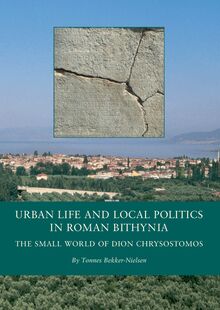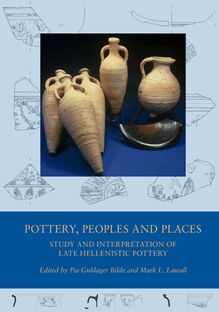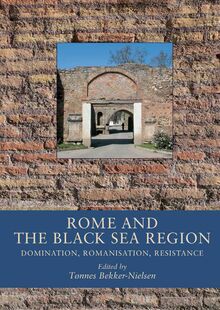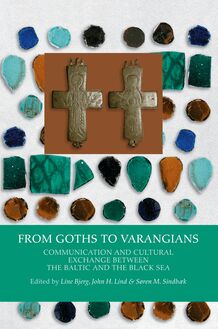Rome and the Black Sea Region , livre ebook
115
pages
English
Ebooks
2006
Vous pourrez modifier la taille du texte de cet ouvrage
Obtenez un accès à la bibliothèque pour le consulter en ligne En savoir plus
Découvre YouScribe en t'inscrivant gratuitement
Découvre YouScribe en t'inscrivant gratuitement
115
pages
English
Ebooks
2006
Vous pourrez modifier la taille du texte de cet ouvrage
Obtenez un accès à la bibliothèque pour le consulter en ligne En savoir plus
Publié par
Date de parution
01 septembre 2006
Nombre de lectures
1
EAN13
9788771246902
Langue
English
Poids de l'ouvrage
2 Mo
Publié par
Date de parution
01 septembre 2006
Nombre de lectures
1
EAN13
9788771246902
Langue
English
Poids de l'ouvrage
2 Mo
BLACK SEA STUDIES
5
THE DANISH NATIONAL RESEARCH FOUNDATION S CENTRE FOR BLACK SEA STUDIES
Edited by T nnes Bekker-Nielsen
ROME AND THE BLACK SEA REGION
Domination, Romanisation, Resistance
Figures and Tables
Jakob Munk H jte:
From Kingdom to Province
Fig. 1 . Satellite image of the Sinop Promontory
Fig. 2 . The number and size of loci in different areas of the Sinop Promontory in the Hellenistic (top) and Roman (bottom) periods (from Doonan 2004, 156-157)
Fig. 3 . Grave stele for Iulia Galatia erected by Antiochos in the year 174 of the local era (AD 171/72), now in Amasya Museum (author s photo)
Fig. 4 . Ethnic composition of the names in the dated inscriptions from Amaseia (based on French 1996)
Table 1. Chronological distribution of the dated inscriptions from Amaseia (based on French 1996)
Table 2. Chronological distribution of the dated inscriptions from Amastris (based on Marek 1993, 157-187)
Table 3. Chronological distribution of the inscriptions from inner Paphlagonia: Neoklaudiopolis, Hadrianopolis, Pompeiopolis, and Germanikopolis (based on Leschhorn 1993, 481-484)
Liviu Petculescu:
The Roman Army as a Factor of Romanisation
Fig. 1 . The Roman Dobrudja (first-third centuries AD), after B rbulescu 2001 with modifications
Fig. 2 . The roads of Roman Dobrudja (second-fourth centuries AD), after B rbulescu 2001
Jesper Majbom Madsen:
Intellectual Resistance to Roman Hegemony and its Representativity
Fig. 1 . The sarcophagus of G. Cassius Chrestus in Nikaia (author s photo)
Fig. 2 . The Rascanii family from Apameia. Bursa Museum (author s photo)
Thomas Corsten:
The R le and Status of the Indigenous Population in Bithynia
Fig. 1 . Map of Roman Bithynia
Anne Marie Carstens:
Cultural Contact and Cultural Change
Fig. 1 . Alabaster vase from the Maussolleion excavations (British Museum, ANE 132114)
Fig. 2 . Cylinder seal from Tomb 813 at Sardis (Dusinberre 1997, fig. 3)
Fig. 3 . Daskyleion bullae depicting a bear hunt (Kaptan 1996, Pl. 26:7)
J rgen Christian Meyer:
What have the Romans done for us?
Fig. 1 . Tetradrachm of the Bar Kokhba revolt, AD 133/4 (University of Aarhus)
Fig. 2 . Antoninianus of Zenobia, AD 271-272 ( Copyright Andreas Pangerl, www.romancoins.info )
Introduction
T nnes Bekker-Nielsen
Domination
In 89 BC, Roman legionaries intervened in the Black Sea region to curb the ambitions of Mithridates VI of Pontos. Over the next two centuries, the Roman presence on the Black Sea coast was slowly, but steadily increased. The annexation of Pontus and Bithynia as a Roman province (63 BC), the transformation of the Bosporan Kingdom into a client power (42 BC) and the establishment of Roman garrisons in the Crimea (AD 64) mark stages in this protracted process. The campaigns of Trajan in Dacia and Armenia (AD 105-114) represent the last great effort of Rome to bring the Pontic area under her sway, and the Periplus of Arrian (AD 130) a stock-taking of Roman domination at its greatest extent, when Rome controlled, directly or indirectly, more than two-thirds of the Black Sea shoreline. Unlike the Mediterranean, the Black Sea never became a Roman lake. Even at the height of Roman power, political control was enforced through a variety of mechanisms, from outright annexation to alliances with native rulers, the details of which have not always found their way into the historical record.
The range of different political and diplomatic instruments used by Rome in the Pontic region reflect her underlying reluctance to undertake a permanent annexation by military means. With large numbers of regular soldiers already committed to the defence of the Rhine, the Danube and Syria, Rome had no need for yet another frontier in the Pontos, nor a limes in the Caucasus. They also, however, reflect the variety of political, geographical and demographical realities that faced Rome on her first encounters with the Black Sea region - where the nomads of the north Pontic steppe zone and the mountain pastoralists of Anatolia coexisted with the Greek-speaking citizens of the coastal cities, ancient Milesian colonies whose inhabitants took pride in their urbanity and civic heritage.
The advent of Rome brought immediate and tangible changes in local power relations, taxation, local administration, to take a few examples. Over time, it entailed innumerable minor and major changes that were not limited to the sphere of economy and politics, nor to the districts under Roman rule. The new order of things came to permeate social life, religion, lifestyle, architecture, language and patterns of consumption.
Romanisation
At least since the time of Theodor Mommsen, Romanisierung or Romanisation has been used as a convenient catch-all term to describe these changes. Though the term has remained in use for over a century, its content and implications have changed. The historiography of Roman expansion and its consequences offer striking proof of Benedotte Croce s dictum that in the last analysis all history is contemporary history . In the late nineteenth and early twentieth century, Roman expansion in Italy was viewed as a natural historical progress analogous to the formation of modern European nation-states; Roman expansion outside Italy as the natural domination of a higher race analogous to the formation of the European overseas empires; and Romanisation as the natural attraction of a higher form of life (Rostovtzeff 1927). For Roman , read Russian, Dutch, British or French; for barbarian , read Algerian, Indian, Indonesian, Cossack or African.
To most thinkers of the early twentieth century, even the more profound ones, imperialism was if not justified, at least compensated by the advantages in terms of law, order, morals and religion imposed by the new masters on their willing or unwilling subjects. Continued European domination under mandated colonial administration, not self-government, was the League of Nations gift to the liberated territories of the vanquished German and Ottoman Empires. The former subjects of the Austrian Empire, on the other hand, were allowed to govern themselves; but then of course they were Europeans.
As with European expansion, the justification of Roman expansion was rarely called into question, and Romanisation was seen to justify Roman dominance or at the very least, as a beneficial spin-off effect of Roman expansion. In the graphic formulation of Francis Haverfield, the Roman empire was an oasis of peace and order; outside its borders roared the wild chaos of barbarism (Haverfield 1924).
The comfortable assumptions on which European imperialism was based were already called into question during the inter-war period and definitely shattered by World War II. The breakup of the colonial empires had begun during the war, gained momentum in the 1950s and was largely complete by the mid-sixties. This did not, however, translate into a reappraisal of Roman imperialism. On the contrary, Rostovtzeff s Rome , firmly rooted in the ideological perceptions of pre-1914 Russian liberalism, was still being reprinted and translated in the 1960 s. To solve this seeming paradox, it needs to be remembered that in its early post-war phase, decolonisation was largely imposed on the European powers by the two new superpowers, both strongly anti-colonialist (though for very different reasons). What eventually made the intellectual establishment of western Europe turn its back on colonialism, however, was the rise of local resistance movements from the mid-1950s onwards, often led by an educated and Europeanised elite who could no longer be dismissed as barbarians .
Resistance
At the same time, the success of the colonial resistance movements inspired a new interest in the historical sociology of resistance and revolution. The case for the existence of hitherto-overlooked movements of social revolt in history was forcefully made by Eric Hobsbawm s Bandits (1971) with the claim that those whom history has recorded as brigands, bandits, robbers and vandals were motivated by a wider social or political agenda. Whatever the merits of Hobsbawm s thesis, it kindled an interest in resistance to Rome and Romanisation. The sixth International Congress of Classical Studies (Pippidi (ed.) 1974) was entirely devoted to the theme of Assimilation and resistance to Graeco-Roman culture and was followed by Stephen Dyson s study of native revolt patterns in Gaul (1975) and Marcel B nabou s monograph on resistance in Roman Africa (1976). As the 1970s gave way to the 1980s, however, a declining interest in ancient resistance movements could be observed. A Crocean reflection of the changing political climate, or merely a general sense of surfeit and tedium after so many words had been expended on the subject?
The postwar phenomenon of global cultural Americanisation also brought the realisation that a dominant power might impose changes in culture, language, lifestyle and patterns of consumption even without the formal political and economic control framework that had characterised the colonial era. Within the study of Roman history, this new insight translated into a dialectical analysis of the relationship between domination and Romanisation and the rediscovery that Romanisation could be an instrument of dominance rather than a consequence.
The study of Romanisation in its Mommsenian sense (as a process of linguistic and institutional assimilation) thus gave way to a concept of Romanisation closer to that of Francis Haverfield (whose classic The Romanisation of Roman Britain was republished in 1979). On the other hand, the new generation of researchers rejected Haverfield s optimistic dualism of Ro



